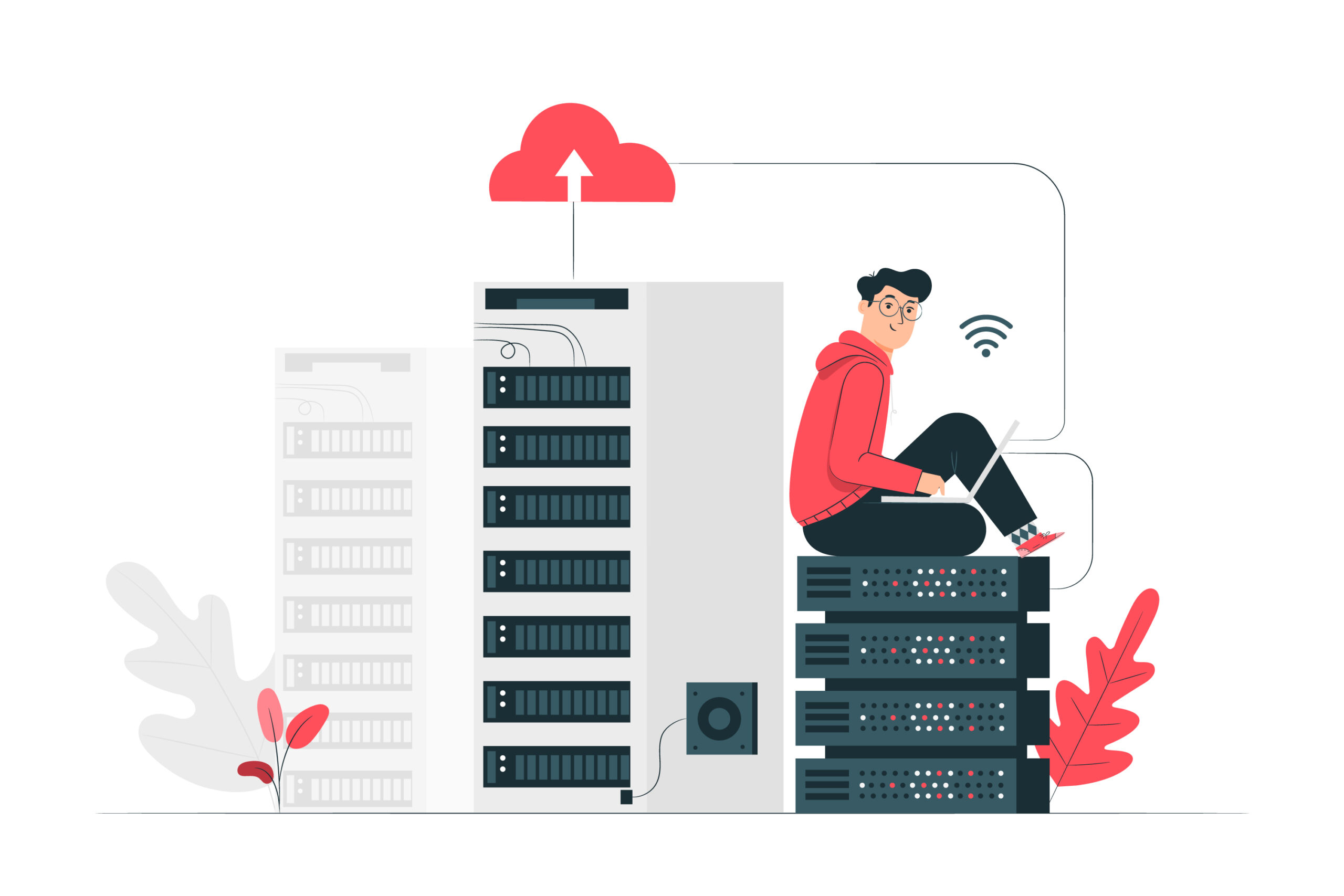What is the cloud
The cloud allows users to access the same files and applications from any device connected to the internet or private network , as processing and storage takes place on servers in a data center, rather than locally on the user’s device. This is why a user can log into their Instagram account on a new phone after the old phone went down and still find their old account in place, with all the photos, videos and conversation history. It works the same with cloud email providers like Gmail or Microsoft Office 365 and with cloud storage providers like Dropbox or Google Drive.
For businesses, moving to cloud computing eliminates some IT costs and overhead costs – for example, they no longer need to upgrade and maintain their servers, as the cloud provider they are using will. This has an impact especially for small businesses that may not be able to afford their own internal infrastructure but can cost-effectively outsource their infrastructure needs via the cloud. The cloud can also make it easier for businesses to operate internationally, as employees and customers can access the same files and applications from any location.
How does cloud computing work?
Cloud computing is possible thanks to a technology called virtualization. Virtualization allows the creation of a simulated “virtual” computer, exclusively digital, which behaves as if it were a physical computer with its own hardware. The technical term for such a computer is virtual machine. When implemented correctly, virtual machines on the same host machine are sandboxed by each other, so they don’t interact with each other at all, and one virtual machine’s files and applications are not visible to other virtual machines even if you are on the same machine physics.
Virtual machines also make more efficient use of the hardware that hosts them . By running multiple virtual machines at the same time, one server becomes many servers and a data center becomes an entire data center host, capable of serving many organizations. Therefore, cloud service providers can offer the use of their servers to many more customers at the same time than they would otherwise be able to, and they can do so at low cost.
A lot of people want to pull their data off the cloud for a range of reasons. Instead of missing out on those great syncing features, though, you can create your own cloud storage service from anywhere.
With iCloud getting hacked so often these days, it’s no surprise that more people want to pull
their data off the cloud server. Instead of missing out on those great syncing features, though, you can create your own cloud storage service that you control with a free service called ownCloud.
How do you build your own cloud storage ?
If you want to create your own cloud storage system, you will need to buy a server from a company like Bluehost.
From there, you can upload to your heart’s content.
A lot of people want to pull their data off the cloud for a variety of reasons. Instead of missing out on those great syncing features, though, you can create your own cloud storage service that you control with a service called ownCloud. The best part: it only takes about five minutes to get it set up.
The nontechnical way: SaaS
In this short tutorial, we’ll show you how to get ownCloud up and running quickly using Docker on macOS, Windows, and 64-bit Linux. If this sounds too technical for you, consider using our software-as-a-service offering ownCloud.online, where we host your very own single-instance ownCloud for a competitive per-user fee. Registration and instance creation only take a few minutes.
Using Docker
While you can install ownCloud the traditional way on a LAMP server consiting of a Linux operating system, an Apache webserver, a Mysql/MariaDB database and PHP, we recommend using Docker for swift delivery and compatibility. Docker delivers software in containers using OS-level virtualization.
Step 1: Install Docker
- Windows: https://docs.docker.com/docker-for-windows/install/
- macOS: https://docs.docker.com/docker-for-mac/install/
- Linux: Install the Docker Engine and Docker Compose according to your OS specifics
Step 2: In your terminal, create the ownCloud folder and cd into the folder (for example mkdir owncloud-docker-server and then cd owncloud-docker-server)
Step 3: Get the Docker compose file, e.g. through wget https://raw.githubusercontent.com/owncloud/docs/master/modules/admin_manual/examples/installation/docker/docker-compose.yml
Step 4: Set the environment parameters needed – please change domain, admin username and admin password accordingly:
cat << EOF > .env
OWNCLOUD_VERSION=10.6
OWNCLOUD_DOMAIN=localhost:8080
ADMIN_USERNAME=admin
ADMIN_PASSWORD=admin
HTTP_PORT=8080
EOF
Step 5: Set up your ownCloud through the command docker-compose up -d and wait until it the process is ready
Step 6: Login to your ownCloud at localhost:8080 or whatever domain you chose to use
Step 7: Install the ownCloud Desktop Client and the ownCloud App for iOS or Android and connect them to your ownCloud
Step 8: Open your browser and log into your new ownCloud at http://localhost:8080!
In an upcoming post, we’ll explain how to add ssl and a custom domain to your new ownCloud.
THE ADVANTAGE OF BUILDING A CLOUD
we can always have all the files we need with us. Whether they are excel sheets, documents, pdfs, images dear to us, in a few seconds they are available on our Android smartphone or on the Iphone or on the PC . The nice thing is that we can also edit these files and then save them in the cloud. This option is very useful when we have to work in a group on a certain document.
Another advantage is the fact that the files located on the cloud are never deleted. If, on the other hand, we save them on a key, hard disk or other support we always risk losing them due to accidental deletion or because, over time, the support has been ruined.
HOW MUCH DOES IT COST TO CREATE A CLOUD
nothing. There are many services that make their server space available for free . Obviously it is not infinite, if we want a free service we have to be satisfied with the space available which is always a lot, in the order of tens of Giga. We practically don’t have to worry about photos, documents, mp3 files. On the other hand, very long and high-resolution videos are heavier, so if we have to create a cloud in which to share a lot of Giga of stuff we will have to opt for a paid service.
WHAT IS NEEDED
we can create it with very little, just any storage system. It can be our wireless hard drive , the hard drive of our computer or a NAS system, see the article: how to share a hard drive on the network .
HOW IT IS CREATED
the time has come to reveal how to create a cloud for sharing with friends and colleagues, obviously protected with an ultra-secure password. As mentioned there are many services that make their space and their servers available. It’s very easy, just choose the one you prefer and sign up with your email and choose a password. That password can be shared with whoever we want and the cloud has been created. Simpler than that. Which cloud storage service to choose? Below is the list, we started with the most spacious ones.
THE BEST FREE STORAGE SERVICES
Pibox : a Tera available for everyone is really a lot. There is no denying space to upload your videos and images in 4K.
Mega : born on the ashes of the old pirate service of the past, it offers 50 Giga of space and access is very fast. If you upload video files you can watch them in streaming with the appropriate app, without waiting for the complete download to be done.
Google Drive: 15 Gb available to share with friends and colleagues. The space management panel is fantastic, we can choose who to give access to and who not, the folders that can be shared and those that must remain private.
Microsoft One drive : even the Redmond giant has thrown itself into this sector by offering 5 Gb for free. The great thing is that it loads photos in the background without having to wait and the integration with Windows 10 is total.
Amazon Drive : 5 Gb free available, the nice thing is that for 70 euros a year we can upload everything we want for our cloud, so unlimited space without restrictions. The first 3 months in the latter case are free.
Dropbox : one of the first to enter the free storage market. 2 Gb free is a little bit these days, but many use it, thanks to the fact that it is very fast and the app is very easy to use.
If you appreciated our effort and our guidance, share it as much as you can , thank you.
Understanding cloud storage and file sharing?
Many years ago, sending large files over the Internet was a big deal. There are many other ways this can work now, thanks to increased bandwidth and more advanced technologies.
What hasn’t changed, however, is the essence of file sharing – you want someone to be able to use a file you’re holding.
How big is the industry?
While not entirely relevant to the key topic in question, file sharing has come a long way and has given rise to some interesting statistics. Some of them can help you decide if file sharing services are right for your business.
- Google Drive is the most popular file sharing service with nearly 35% market share .
- The global business file sharing and syncing market will reach a value of $ 16.99 billion by 2025 .
- McAfee found that 87% of companies have experienced a business boost from using Cloud services.
A terabyte of data costs about $ 3,351 to keep for one year. - Types of file sharing technologies
To give a better idea of why we list we Cloud Storage and file sharing services together, we need to understand that there are various ways to achieve the same thing. While both services may be marketed in different ways, you simply want multiple users to get access to certain files.
Some of the things involved may include:
1. File transfer protocol
This data transfer protocol was introduced to help move large chunks of data across networks. Today it remains one of the most popular means of file transfer. It can be run via the command line or via specialized File Transfer Protocol (FTP) clients such as FileZilla.
2. Peer to Peer
While file download enthusiasts often refer to it as “Torrenting”, Peer-to-Peer (P2P) file transfer is a more accurate name. P2P is sharing data using an index file, with the actual data spread across multiple client systems. Essentially, it is a distributed file storage system.
3. Cloud services
Similar to P2P, cloud services run on a distributed SaaS compute model file . However, rather than an index file, cloud services offer a single repository for files that can have shared access. Examples of this include Dropbox and Microsoft OneDrive, where you can control file access permissions.
Pros and cons of file sharing
File sharing makes things very convenient but it’s not always an ideal solution, especially for business use. Here are some of the pros and cons to keep in mind when opting for a file sharing service.
- Benefits of File Sharing
Easily transfer large volumes of data - It often allows for collaborative work
- Reduces the risk of centralized storage
Cons of file sharing
- It can increase your bandwidth costs
- It can make it difficult to comply with data location restrictions
- Increased risk of malware or file tampering
Secure File Sharing Tips for Businesses
There are basic guidelines you should observe if you intend to share files with employees or even customers. Here are some best practices to make sure your file sharing activities remain safe.
- Audits are needed to make sure you know who is sharing (and accessing) the files you share.
- Keep track of file permissions and not everything is meant for full access.
- Use services that include end-to-end encryption so that data can do so; they are not intercepted and stolen.
- Ideally, make sure there is a system in place that can manage and document file versions.
- Avoid overly technical names and keep filenames user readable.
- Free cloud storage options versus paid ones Many services now operate on a freemium model – free web hosting , free email marketing tools , free website builders , SSL free , and so on.
Free cloud storage means that you can, in fact, technically use some cloud storage or file sharing services at no cost. No cash payments does not mean that you will get by without a problem.
Almost without exception, any free service will extract the payment in another form, typically your personal data. By using the information provided, most services will be able to use this data in many ways.
Some may target ads your way, while others may even sell or otherwise provide your data to third parties. That’s not exactly what you want to happen.
How vital is cloud storage for your business?
As you can probably understand from the list of these cloud storage and file sharing providers, there is a big discrepancy in the breadth of services each service provider offers. Some excel at the consumer level, while others go out of their way to satisfy business users.
The key element in choosing the perfect service provider for you or your business is the same as always: consider your needs carefully. For example, although Box offers extremely detailed functionality, not all companies will have to comply with many regulations and the like. In cases like this, a more consumer-friendly option might be a better choice, like Google’s core ecosystem.
List exactly what you think your business requires before making a selection, you could save yourself a lot of trouble when faced with more features you don’t use and pay for.
Conclusion
If you are looking for more control, security and flexibility, plus you’ve got someone really tech based on board, then perhaps a DIY cloud storage is an option for you. Certainly Nextcloud and ownCloud are top of the list as they are easy to use and manage. You can try other platforms like Seafile of Pydio for instance if speed is your main concern.





